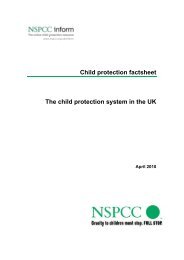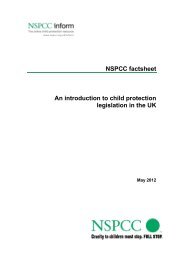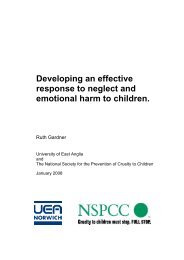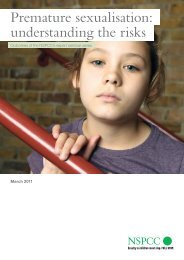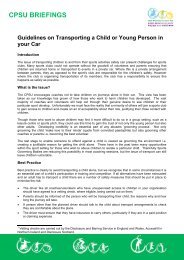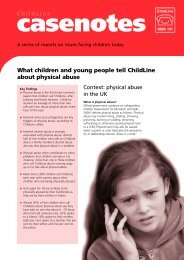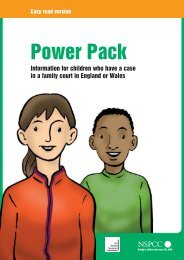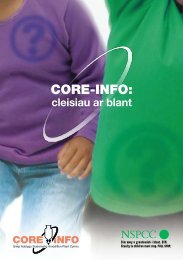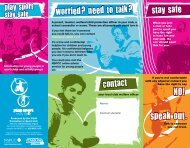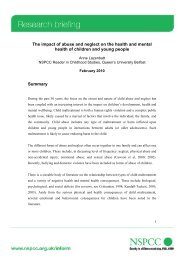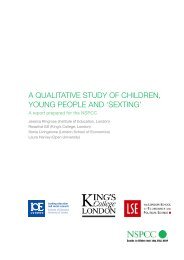Neglect and serious case reviews (PDF, 735KB) - nspcc
Neglect and serious case reviews (PDF, 735KB) - nspcc
Neglect and serious case reviews (PDF, 735KB) - nspcc
You also want an ePaper? Increase the reach of your titles
YUMPU automatically turns print PDFs into web optimized ePapers that Google loves.
3. extreme <strong>Neglect</strong> / deprivatioNal abuSe<br />
Cases where the direct cause of death is extreme neglect or deprivation of the child’s<br />
needs, e.g. through starvation or exposure, or where there is evidence of deliberate<br />
failure to respond to medical needs of the child.<br />
exclusion criteria<br />
Exclude deaths in which the neglect appears be a reflection of parental incompetence,<br />
related to learning difficulties, physical or mental ill-health, or other environmental<br />
circumstances (treat as deaths related to but not directly caused by maltreatment<br />
– category 5). Exclude ab<strong>and</strong>onment of very young infants (category 1). Exclude<br />
accidental deaths related to poor parental supervision (category 5). Exclude <strong>case</strong>s where<br />
neglect contributed to the death, but there is no evidence of persistent neglect in other<br />
areas (category 5).<br />
4. deliberate / overt homicideS<br />
This overlaps with the first category of infanticide/covert homicide, in that there would<br />
appear to be an intent to kill the child; but differs from that <strong>and</strong> other groups in the age<br />
profile, in the victim <strong>and</strong> perpetrator characteristics <strong>and</strong> in the typical mode of death. In<br />
these deaths, the fact of homicide is likely to be immediately apparent. Include deaths<br />
caused by stabbings <strong>and</strong> firearms; include severe beatings where there appears to be<br />
an intent to kill. Include homicides with associated sexual assaults; include <strong>case</strong>s of<br />
killings of multiple family members or of multiple killings with subsequent suicide of<br />
the perpetrator (‘extended suicides’). This may include deaths from house fires with<br />
evidence of arson with intent to kill.<br />
exclusion criteria<br />
Exclude severe injuries where there is no evidence of intent to kill (category 2); <strong>case</strong>s<br />
where the homicide is not immediately apparent (category 1).<br />
5. deathS related to but Not directly cauSed by maltreatmeNt<br />
Appendix B<br />
Deaths which are felt to be related to maltreatment, but in which the maltreatment<br />
cannot be considered a direct cause of death. Include sudden unexpected deaths in<br />
infancy (category 5a) with clear concerns around parental care, but not sufficient to label<br />
as extreme or persistent neglect (category 3). Include fatal accidents where there may<br />
be issues of parental supervision <strong>and</strong> care, including accidental ingestion of drugs or<br />
other household substances; drownings; falls; electrocution; gunshot wounds; <strong>and</strong> fires.<br />
Includes those children dying of natural causes whose parents may not have sought<br />
medical intervention early enough. Include deaths of older children with previous<br />
maltreatment, but where the maltreatment did not directly lead to the death, e.g. death<br />
from an overwhelming chest infection in a child severely disabled by a non-accidental<br />
89




